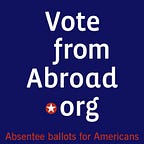Request, receive, return: the challenges of casting your overseas ballot
Americans living abroad are 13 times less likely to vote in U.S. elections than our compatriots back home. So what keeps us from casting those — often deciding — votes?
An estimated 4.8 million Americans live abroad — and 2.9m of us are eligible to stand up and be counted as UOCAVA (aka Uniformed and Overseas Citizens Absentee Voting Act) voters. But only 4.7% of United States expats voted in the 2018 election. While 4.7% sounds “shockingly low,” as the article, Voting is for All Americans, Including Those Living Abroad — published in the July issue of The Canvass — points out, in 2018 overseas voting was up by 30% over 2014. An impressive rise.
And yet despite this increase, Americans living abroad are 13 times less likely to vote in U.S. elections than our compatriots back home. So what keeps us from casting those — often deciding — votes?
According to the Overseas Citizen Population Analysis Report from the Federal Voting Assistance Program (FVAP) 31% of overseas Americans “didn’t want to vote” and 69% of overseas Americans “couldn’t complete the process”.
What stands in the way of the 69%? The cards can sometimes be stacked against overseas voters.
Compare and contrast:
· a lawyer in Singapore with no email or postage connectivity issues
· a Doctors Without Borders volunteer without easy access to stamps
· a sailor on a U.S. Navy vessel where printers and physical mail might be problematic
For a decade, federal funding has allowed states to try various methods for rounding up absentee ballots, explains The Canvass. It reckons that the UOCAVA market is too small to be attractive to technology vendors, although the companies Democracy Live and Voatz have been working to “crack the ballot transmission market and solve the security issues.”
The National Institute for Standards and Technology (NIST) voices security concerns about electronic voting, but in 31 states voters can return ballots by email, fax, or through a web portal.
Both the obstacles to voting and the solutions to surmounting those obstacles differ from state to state — but customer service is universally key in tackling what David Beirne at FVAP calls the “vacuum of information” that overseas voters are often confronted by. What encourages them along is positive reinforcement and communication from election officials like: “Yes, we received your application!” “Yes, we received your ballot!” “Yes, your ballot was counted!”
At Vote from Abroad we pull out all the stops with our extensive FAQs on registering to vote and on requesting, receiving and returning your ballot. We can assist you with your Federal Post Card Application (aka FPCA) or Federal Write-In Absentee Ballot (aka FWAB).
Uncle Sam wants to hear from you! So if you haven’t already, step up to the plate and register to vote. As Americans abroad, we’ve increasingly got the power.
See The Canvass for more details, including tech-based and non-tech solutions to voting-from-abroad challenges
Further reading:
· U.S. Citizens Abroad and their Voting Behaviors in 2018 — great graphics from FVAP
· Examining the Sustainability of Balloting Solutions for Military & Overseas Voting
